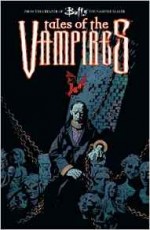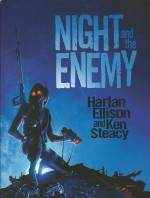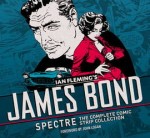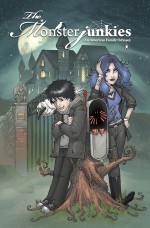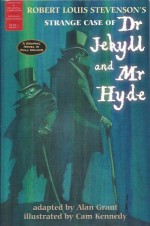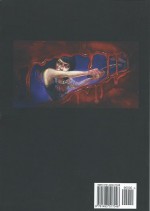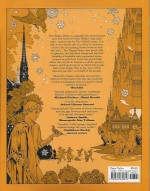
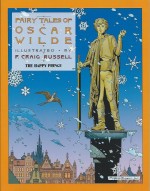
Adapted by P. Craig Russell (NBM)
ISBN: 978-1-56163-981-6
Craig Russell began his illustrious career in comics during the early 1970s and came to prominence young through a groundbreaking run on science fiction adventure series Killraven, Warrior of the Worlds.
Although his fanciful, meticulous, classicist style was joyously derived from the great illustrators of Victorian and Edwardian heroic fantasy and his craftsmanlike visual flourishes of Art Nouveau were greatly at odds with the sausage-factory deadlines and sensibilities of the mainstream comicbook industry, the sheer power and beauty of his work made him a huge draw.
By the 1980s he had largely retired from the merciless daily grind, preferring to work on his own projects (generally adapting operas and plays into sequential narratives) whilst undertaking the occasional high-profile special for the majors – such as Dr. Strange Annual 1976 – completely reworked and re-released as Dr. Strange: What Is It that Disturbs You, Stephen? in 1996 – or Batman: Robin 3000.
As the industry at last matured – in the midst of a fantasy boom – Russell returned to comics with Marvel Graphic Novel: Elric (1982), further co-adapting prose tales of Michael Moorcock’s iconic sword-&-sorcery star in Epic Illustrated magazine and elsewhere.
Russell’s stage-arts adaptations had begun appearing in 1978: first in the independent Star*Reach specials Night Music and Parsifal and then from 1984 at Eclipse Comics where the revived Night Music became an anthological showcase for his earlier experimental adaptations; not simply operatic dramas but also rousing timeless adventure tales from Kipling’s Jungle Books and other literary classics.
In 1992 he began adapting the Fairy Tales of Oscar Wilde – a mission he continues to date, with this fifth volume (in its second printing) deftly transforming the author’s heartbreaking and salutary allegorical fable of pure virtue and human hypocrisy into a work of capital “A†graphic Art.
First published in May 1888, The Happy Prince and Other Tales was Wilde’s first book for children with the lead story merely one of a quintet of literary gems – the others being The Nightingale and the Rose, The Selfish Giant, The Devoted Friend and The Remarkable Rocket – and here adaptor Russell utilises all his skills to staggering effect and creates an evocative, beguiling sensation.
Sacrificing the usual Wildean bon mots for wickedly earnest and ferociously barbed social criticism, this riveting fable is set in a prosperous town where all the important people revel in the beauty of the golden, gem-bedecked statue of a former prince who died young and spoiled in the lap of overwhelming luxury.
Now his spirit resides in a gleaming, glittering statue and from his lofty perch the gilded potentate can view the entire town. However, within his metal frame his lead heart is crushed by the suffering and poverty of the poor he sees in every dark, ignored corner of the metropolis.
As the seasons turn the suffering statue convinces the last swallow in the land to forego migration to Egypt and has the plucky, cocky bird methodically strip him of the jewels and gold which make him such a resplendent sight before secretly redistributing these riches to those who need them most…
As winter comes and the statue’s resources dwindle, the swallow too is failing. The rich folk are soon embarrassed by the state of their former premier monument and react typically, all blithely unaware of the subtle change which has embraced the lower classes, who are now warm, fed and happy for the first time… but only at a terrible unsuspected cost to the boy and the bird…
I wasn’t kidding about heartbreaking. Our Victorian ancestors knew the value and power of pathos and sentiment and weren’t shy in using it to give kids all the emotional tools they needed for growing up.
It’s a gift we sadly lost sometime in the 1980s when we began cocooning and obsessively shielding our young from life’s darker aspects, and whilst it might have saved a few parents having difficult talks with their children, it deprived future generations of much-needed understanding and empathy.
This is a very sad story – think “Feed the Birds†in the Mary Poppins movie and lay in sufficient supplies of hankies – but one that every child and their appointed caretakers absolutely must see, especially in today’s world of cruel, crushing, crippling One-Percentism and facile, vapid, selfish self-aggrandisement…
Like all the other volumes in this series, The Happy Prince is another high point in Russell’s splendid, stellar career: an incredibly lovely, irresistibly readable example of superb writing – so go and read Wilde’s original prose tomes too – and sublime comic art at its very best.
Now that it’s finally back in print, you simply must avail yourself of this magically meaningful masterpiece…
© 2012 P. Craig Russell. All rights reserved.

